Spatio-Temporal Pattern of Groundwater Nitrate-Nitrogen and Its Potential Human Health Risk in a Severe Water Shortage Region
Abstract
:1. Introduction
2. Materials and Methods
2.1. Study Area
2.2. Sample Analysis
2.2.1. Sample Determination
2.2.2. Quality Control
2.3. Exposure and Health Risk Assessment
2.4. Data Analysis and Statistics
3. Results and Discussion
3.1. The Spatio-Temporal Distribution
3.1.1. Spatial Distribution Characteristics
3.1.2. Temporal Variation
3.2. Response of NO3− Concentration to Land-Use Types
3.3. Health Risk Assessment
3.3.1. HQ among Different Age Groups
3.3.2. HQ in Urban and Suburban Areas
3.3.3. The Tendency of Non-Carcinogenic Risk over Time
4. Conclusions
Supplementary Materials
Author Contributions
Funding
Institutional Review Board Statement
Informed Consent Statement
Data Availability Statement
Acknowledgments
Conflicts of Interest
References
- Dong, W.W.; Zhang, Y.; Quan, X. Health risk assessment of heavy metals and pesticides: A case study in the main drinking water source in Dalian, China. Chemosphere 2020, 242, 125113. [Google Scholar] [CrossRef] [PubMed]
- Elisante, E.; Muzuka, A.N.N. Assessment of sources and transformation of nitrate-nitrogen in groundwater on the slopes of Mount Meru, Tanzania. Environ. Earth Sci. 2016, 75, 277. [Google Scholar] [CrossRef]
- Perez-Fernandez, M.A.; Calvo-Magro, E.; Valentine, A. Benefits of the Symbiotic Association of Shrubby Legumes for the Rehabilitation of Degraded Soils under Mediterranean Climatic Conditions. Land Degrad. Dev. 2016, 27, 395–405. [Google Scholar] [CrossRef]
- Nakagawa, K.; Amano, H.; Takao, Y.; Hosono, T.; Berndtsson, R. On the use of coprostanol to identify source of nitrate-nitrogen pollution in groundwater. J. Hydrol. 2017, 550, 663–668. [Google Scholar] [CrossRef]
- Green, C.T.; Liao, L.X.; Nolan, B.T.; Juckem, P.F.; Shope, C.L.; Tesoriero, A.J.; Jurgens, B.C. Regional Variability of Nitrate-nitrogen Fluxes in the Unsaturated Zone and Groundwater, Wisconsin, USA. Water Resour. Res. 2018, 54, 301–322. [Google Scholar] [CrossRef]
- Ti, C.P.; Xia, L.L.; Chang, S.X.; Yan, X.Y. Potential for mitigating global agricultural ammonia emission: A meta-analysis. Environ. Pollut. 2019, 245, 141–148. [Google Scholar] [CrossRef]
- Badeenezhad, A.; Radfard, M.; Passalari, H.; Parseh, I.; Abbasi, F.; Rostami, S. Factors affecting the nitrate-nitrogen concentration and its health risk assessment in drinking groundwater by application of Monte Carlo simulation and geographic information system. Hum. Ecol. Risk Assess. 2019, 27, 1458–1471. [Google Scholar] [CrossRef]
- Pirsaheb, M.; Khosravi, T.; Fazlzadeh, M.; Sharafie, K. Effects of loading rate, resin height, and bed volume on nitrate-nitrogen removal from drinking water by non-selective strong anion exchange resin (A400E). Desalination Water Treat. 2017, 89, 127–135. [Google Scholar] [CrossRef]
- Qasemi, M.; Farhang, M.; Biglari, H.; Afsharnia, M.; Ojrati, A.; Khani, F.; Samiee, M.; Zarei, A. Health risk assessments due to nitrate-nitrogen levels in drinking water in villages of Azadshahr, northeastern Iran. Environ. Earth Sci. 2018, 77, 782. [Google Scholar] [CrossRef]
- Feng, W.W.; Wang, C.; Lei, X.H.; Wang, H.; Zhang, X.L. Distribution of Nitrate-nitrogen Content in Groudwater and Evaluation of Potential Health Risks: A Case Study of Rural Area in Northern China. Int. J. Environ. Res. Public Health 2020, 17, 9390. [Google Scholar] [CrossRef]
- Kumar, P.; Dasgupta, R.; Johnson, B.A.; Saraswat, C.; Basu, M.; Kefi, M.; Mishra, B.K. Effect of Land Use Change on Water Quality in an Ephemeral Coastal Plain: Khambhat City, Gujarat, India. Water 2019, 11, 724. [Google Scholar] [CrossRef]
- Li, P.Y.; Wu, J.H.; Qian, H. Groundwater quality assessment based on rough sets attribute reduction and TOPSIS method in a semi-arid area, China. Environ. Monit. Assess. 2012, 184, 4841–4854. [Google Scholar] [CrossRef] [PubMed]
- Mostafizur, R.M.; Bodrud-Doza, M.; Iftakharul, M.M.; Binte, K.F.H.; Sikder, M.T.; Mashura, S.; Rubaiya, A.; Khabir, U.M. Human Health Risk Assessment of Nitrate-nitrogen and Trace Metals Via Groundwater in Central Bangladesh. Pollution 2020, 6, 253–266. [Google Scholar] [CrossRef]
- Sadler, R.; Maetam, B.; Edokpolo, B.; Connell, D.; Yu, J.; Stewart, D.; Park, M.J.; Gray, D.; Laksono, B. Health risk assessment for exposure to nitrate-nitrogen in drinking water from village wells in Semarang, Indonesia. Environ. Pollut. 2016, 216, 738–745. [Google Scholar] [CrossRef] [PubMed]
- Wu, J.H.; Sun, Z.C. Evaluation of Shallow Groundwater Contamination and Associated Human Health Risk in an Alluvial Plain Impacted by Agricultural and Industrial Activities, Midwest China. Expo. Health 2016, 8, 311–329. [Google Scholar] [CrossRef]
- Badeenezhad, A.; Radfard, M.; Radfard, M.; Abbasi, F.; Jurado, A.; Bozorginia, M.; Jalili, M.; Soleimani, H. Effect of land use changes on non-carcinogenic health risks due to nitrate-nitrogen exposure to drinking groundwater. Environ. Sci. Pollut. Res. 2021, 28, 41937–41947. [Google Scholar] [CrossRef]
- Sakizadeh, M.; Zhang, C.S. Health risk assessment of nitrate-nitrogen using a probalilistic approach in groundwater resources of western part of Iran. Environ. Earth Sci. 2020, 79, 43. [Google Scholar] [CrossRef]
- Schullehner, J.; Hansen, B.; Thygesen, M.; Pedersen, C.B.; Sigsgaard, T. Nitrate-nitrogen in drinking water and colorectal cancer risk: A nationwide population-based cohort study. Int. J. Cancer 2018, 143, 73–79. [Google Scholar] [CrossRef]
- Wu, J.L.; Yin, Y.N.; Wang, J.L. Hydrogen-based membrane biofilm reactors for nitrate-nitrogen removal from water and wastewater. Int. J. Hydrog. Energy 2018, 43, 1–15. [Google Scholar] [CrossRef]
- Gao, S.; Li, C.S.; Jia, C.; Zhang, H.L.; Guan, Q.; Wu, X.C.; Wang, J.X.; Lv, M.H. Health risk assessment of groundwater nitrate-nitrogen contamination: A case study of a typical karst hydrogeological unit in East China. Environ. Sci. Pollut. Res. 2020, 27, 9274–9287. [Google Scholar] [CrossRef]
- Radfard, M.; Gholizadeh, A.; Azhdarpoor, A.; Badeenezhad, A.; Mohammadi, A.A.; Yousefi, M. Health risk assessment to fluoride and nitrate-nitrogen in drinking water of rural residents living in the Bardaskan city, arid region, southeastern Iran. Desalination Water Treat. 2019, 145, 249–256. [Google Scholar] [CrossRef]
- Zhai, Y.Z.; Zhao, X.B.; Teng, Y.G.; Li, X.; Zhang, J.J.; Wu, J.; Zuo, R. Groundwater nitrate pollution and human health risk assessment by using HHRA model in an agricultural area, NE China. Ecotoxicol. Environ. Saf. 2017, 137, 130–142. [Google Scholar] [CrossRef] [PubMed]
- Fallahazadeh, R.A.; Almodarest, S.A.; Dashti, M.M.; Fattahi, A.; Sadeghnia, M.; Eslami, H.; Khosravi, R.; Minaee, R.P.; Taghavi, M. Zoning of Nitrite and Nitrate-nitrogen Concentration in Groundwater Using Geografic Information System (GIS), Case Study: Drinking Water Wells in Yazd City. J. Geosci. Environ. Prot. 2016, 4, 91–96. [Google Scholar] [CrossRef]
- Singh, N.; Singh, V.; Rai, S.N.; Vamanu, E.; Singh, M.P. Metagenomic analysis of garden soil-derived microbial consortia and unveiling their metabolic potential in mitigating toxic hexavalent chromium. Life 2022, 12, 2094. [Google Scholar] [CrossRef]
- Singh, V.; Verma, M. Microbial removal of Cr (VI) by a new bacterial strain isolated from the site contaminated with coal mine effluents. J. Environ. Chem. Eng. 2021, 9, 106279. [Google Scholar] [CrossRef]
- US EPA. National Primary Drinking Water Regulations. 2009. Available online: https://www.epa.gov/ground-water-and-drinking-water/national-primary-drinking-water-regulation-table (accessed on 8 September 2023).
- Mallya, C.L.; Rwiza, M.J. Influence of land use change on nitrate-nitrogen sources and pollutant enrichment in surface and groundwater of a growing urban area in Tanzania. Environ. Earth Sci. 2021, 80, 111. [Google Scholar] [CrossRef]
- Adimalla, N. Spatial distribution exposure, and potential health risk assessment from nitrate-nitrogen in drinking water from semi-arid region of South India. Hum. Ecol. Risk Assess. 2020, 26, 310–334. [Google Scholar] [CrossRef]
- Aghapour, S.; Bina, B.; Tarrahi, M.J.; Amiri, F.; Ebrahimi, A. Comparative health risk assessment of nitrate-nitrogen in drinking groundwater resources of urban and rural regions (Isfahan, Iran), using GIS. Environ. Monit. Assess. 2021, 193, 794. [Google Scholar] [CrossRef]
- Hansen, B.; Thorling, L.; Schullehner, J.; Termansen, M.; Dalgaard, T. Groundwater nitrate response to sustainable nitrogen management. Sci. Rep. 2017, 7, 8566. [Google Scholar] [CrossRef]
- Lee, C.-M.; Hamm, S.-Y.; Cheong, J.-Y.; Kim, K.; Yoon, H.; Kim, M.; Kim, J. Contribution of nitrate-nitrogen concentration in groundwater to stream water in an agricultural head watershed. Environ. Res. 2020, 184, 109313. [Google Scholar] [CrossRef]
- Abascal, E.; Gómez-Coma, L.; Ortiz, I.; Ortiz, A. Global diagnosis of nitrate pollution in groundwater and review of removal technologies. Sci. Total Environ. 2022, 810, 152233. [Google Scholar] [CrossRef] [PubMed]
- Gardner, S.G.; Levison, J.; Parker, B.L.; Martin, R.C. Groundwater nitrate in three distinct hydrogeologic and land-use settings in southwestern Ontario, Canada. Hydrogeol. J. 2020, 28, 1891–1908. [Google Scholar] [CrossRef]
- Li, Y.; Bi, Y.H.; Mi, W.J.; Xie, S.L.; Ji, L. Land-use change caused by anthropogenic activities increase fluoride and arsenic pollution in groundwater and human health risk. J. Hazard. Mater. 2021, 406, 124337. [Google Scholar] [CrossRef] [PubMed]
- Zhang, H.; Xu, Y.; Cheng, S.Q.; Li, Q.L.; Yu, H.R. Application of the dudl-isotope approach and Bayesian isotope mixing model to identify nitrate-nitrogen in groundwater of a multiple land-use area in Chengdu Plain, China. Sci. Total Environ. 2020, 717, 137134. [Google Scholar] [CrossRef] [PubMed]
- Zheng, W.; Wang, S. Extreme precipitation accelerates the contribution of nitrate sources from anthropogenetic activities to groundwater in a typical headwater area of the North China Plain. J. Hydrol. 2021, 603, 127110. [Google Scholar] [CrossRef]
- Salman, S.A.; Shahid, S.; Mohsenipour, M.; Asgari, H. Impact of landuse on groundwater quality of Bangladesh. Sustain. Water Resour. Manag. 2018, 4, 1031–1036. [Google Scholar] [CrossRef]
- Cao, X. Policy and regulatory responses to coalmine closure and coal resources consolidation for sustainability in Shanxi, China. J. Clean. Prod. 2017, 145, 199–208. [Google Scholar] [CrossRef]
- Shan, L.J. Feature Analysis of Dynamic Variation of Groundwater in Taiyuan City. Shanxi Coal. 2019, 39, 8–13. [Google Scholar] [CrossRef]
- Li, Y.; Ji, L.; Mi, W.J.; Xie, S.L.; Bi, Y.H. Health risks from groundwater arsenic on residents in northern China coal-rich region. Sci. Total Environ. 2021, 773, 145003. [Google Scholar] [CrossRef]
- Li, D.; Zhai, Y.; Lei, Y.; Li, J.; Yanguo, T.; Lu, H.; Xia, X.; Yue, W.; Yang, J. Spatiotemporal evolution of groundwater nitrate nitrogen levels and potential human health risks in the Songnen Plain, Northeast China. Ecotoxicol. Environ. Saf. 2021, 208, 111524. [Google Scholar] [CrossRef]
- National Health Commission of the People’s Republic of China. Standards for Drinking Water Quality (GB5749-2022). 2023. Available online: https://std.samr.gov.cn/search/std?q=GB5749-2022 (accessed on 8 September 2023).
- Jia, Z.M.; Li, S.Y.; Wang, L. Assessment of soil heavy metals for eco-environment and human health in a rapidly urbanization area of the upper. Sci. Rep. 2018, 8, 3256. [Google Scholar] [CrossRef] [PubMed]
- Chen, F.J.; Lao, Q.B.; Zhang, S.W.; Bain, P.W.; Jin, G.Z.; Zhu, Q.M.; Chen, C.Q. Nitrate-nitrogen sources and biogeochemical process identified using nitrogen and oxygen isotopes on the eastern coast of Hainan Island. Cont. Shelf Res. 2020, 207, 104209. [Google Scholar] [CrossRef]
- Groh, T.A.; Isenhart, T.M.; Schultz, R.C. Long-term nitrate-nitrogen removal in three riparian buffers: 21 years of data from the Bear Creek watershed in central lowa, USA. Sci. Total Environ. 2020, 740, 140114. [Google Scholar] [CrossRef] [PubMed]
- Yu, G.M.; Wang, J.; Liu, L.; Li, Y.; Zhang, Y.; Wang, S.S. The analysis of groundwater nitrate-nitrogen pollution and health risk assessment in rural areas of Yantai, China. Bmc Public Health 2020, 20, 437. [Google Scholar] [CrossRef]
- Lasagna, M.; De Luca, D.A.; Franchino, E. Nitrate-nitrogen contamination of groundwater in the western Po Plain (Italy): The effects of groundwater and surface water interactions. Environ. Earth Sci. 2016, 75, 240. [Google Scholar] [CrossRef]
- US EPA. National Primary Drinking Water Regulations. 2012. Available online: https://nepis.epa.gov/Exe/ZyPDF.cgi/P100N01H.PDF?Dockey=P100N01H.PDF (accessed on 8 September 2023).
- US EPA. National Primary Drinking Water Regulations. 2013. Available online: https://www.epa.ie/publications/compliance--enforcement/drinking-water/Drinking-Water-Report-Web.pdf (accessed on 8 September 2023).
- Azhdarpoor, A.; Radfard, M.; Pakdel, M.; Abbasnia, A.; Badeenezhad, A.; Mohammadi, A.A.; Yousefi, M. Assessing fluoride and nitrate-nitrogen contaminants in drinking water resources and their health risk assessment in a semiarid region of southwest Iran. Desalination Water Treat. 2019, 149, 43–51. [Google Scholar] [CrossRef]
- Fabro, A.Y.R.; Avila, J.G.P.; Alberich, M.V.E.; Sansores, S.A.C.; Camargo-Valero, M.A. Spatial distribution of nitrate-nitrogen health risk associated with groundwater use as drinking water in Merida, Mexico. Appl. Geogr. 2015, 65, 49–57. [Google Scholar] [CrossRef]
- Qasemi, M.; Farhang, M.; Morovati, M.; Mahmoudi, M.; Ebrahimi, S.; Abedi, A.; Bagheri, J.; Zarei, A.; Bazeli, J.; Afsharnia, M.; et al. Investigation of potential human health risks from fluoride and nitrate-nitrogen via water consumption in Sabzevar, Iran. Int. J. Environ. Anal. Chem. 2020, 102, 307–318. [Google Scholar] [CrossRef]
- Pasten-Zapata, E.; Ledesma-Ruiz, R.; Harter, T.; Ramirez, A.I.; Mahlknecht, J. Assessment of sources and fate of nitrate-nitrogen in shallow groundwater of an agricultural area by using a multi-tracer approach. Sci. Total Environ. 2014, 470, 855–864. [Google Scholar] [CrossRef]
- Ezekwe, I.C.; Odu, N.N.; Chima, G.N.; Opigo, A. Assessing regional groundwater quality and its health implications in the Lokpaukwu, Lekwesi and Ishiagu mining areas of southeastern Nigeria using factor analysis. Environ. Earth Sci. 2012, 67, 971–986. [Google Scholar] [CrossRef]
- Su, X.S.; Wang, H.; Zhang, Y.L. Health Risk Assessment of Nitrate-nitrogen Contamination in Groundwater: A Case Study of an Agricultural Area in Northeast China. Water Resour. Manag. 2013, 27, 3025–3034. [Google Scholar] [CrossRef]
- Paul, M.J.; Meyer, J.L. Streams in the urban landscape. Annu. Rev. Ecol. Syst. 2001, 32, 333–365. [Google Scholar] [CrossRef]
- Tsegaye, T.; Sheepard, D.; Islam, K.R.; Johnson, A.; Tadesse, W. Development of chemical index as ameasure of in-stream water quality in response to land-use and land-cover changes. Water Air Soil Pollut. 2006, 174, 161–179. [Google Scholar] [CrossRef]
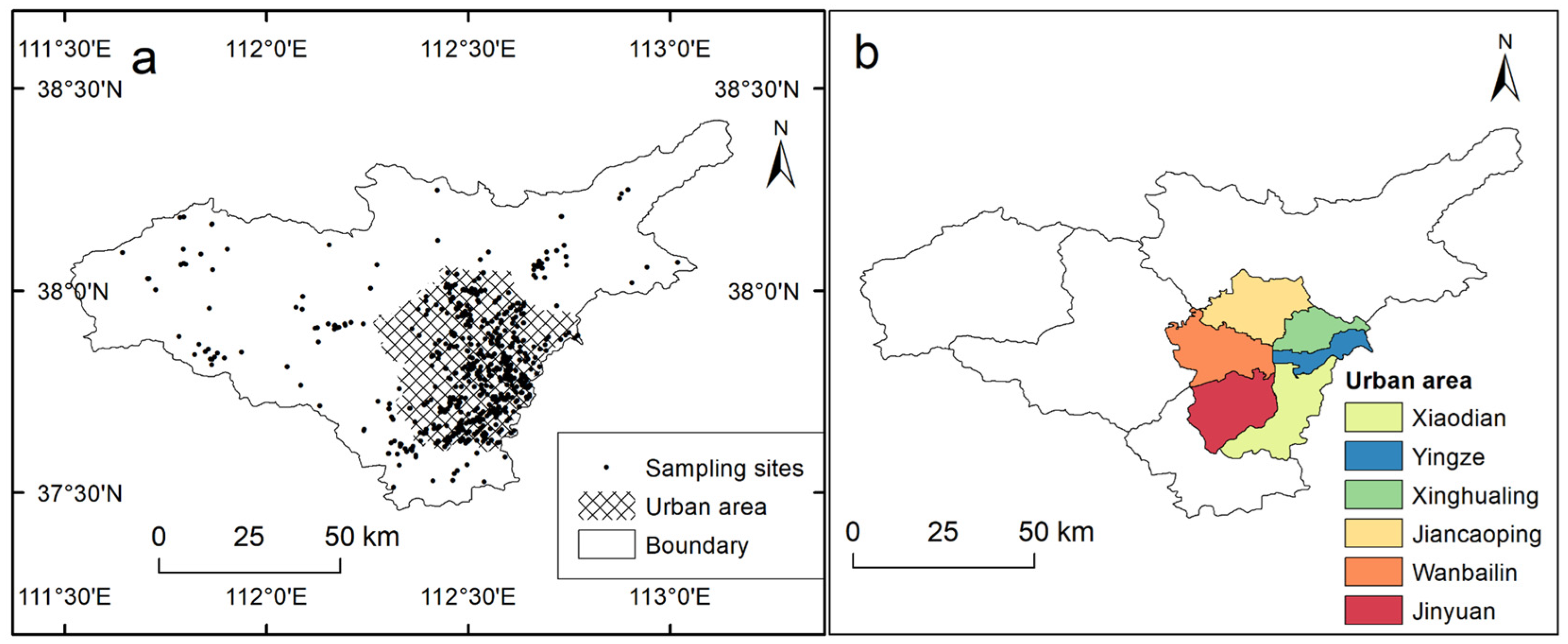
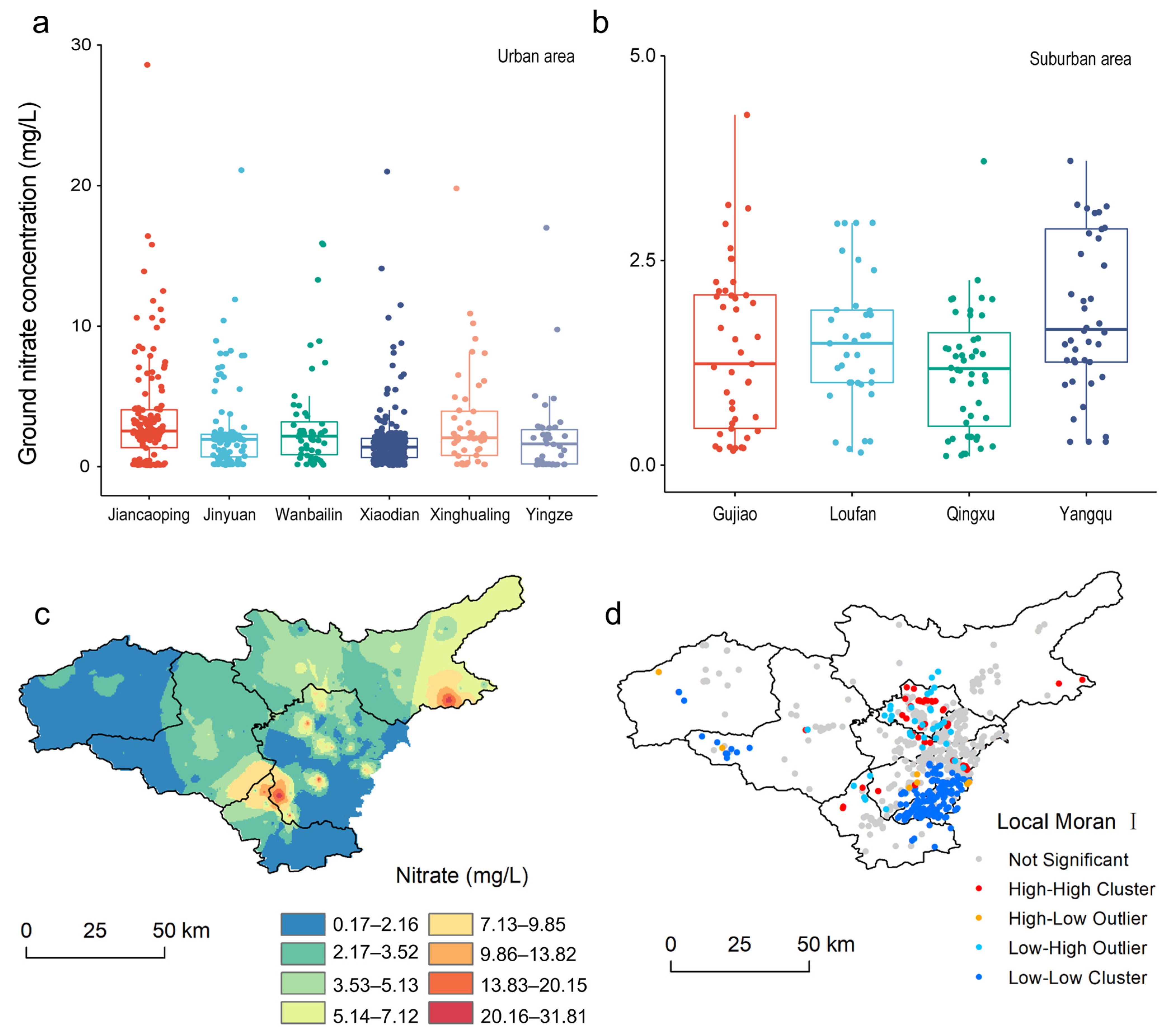
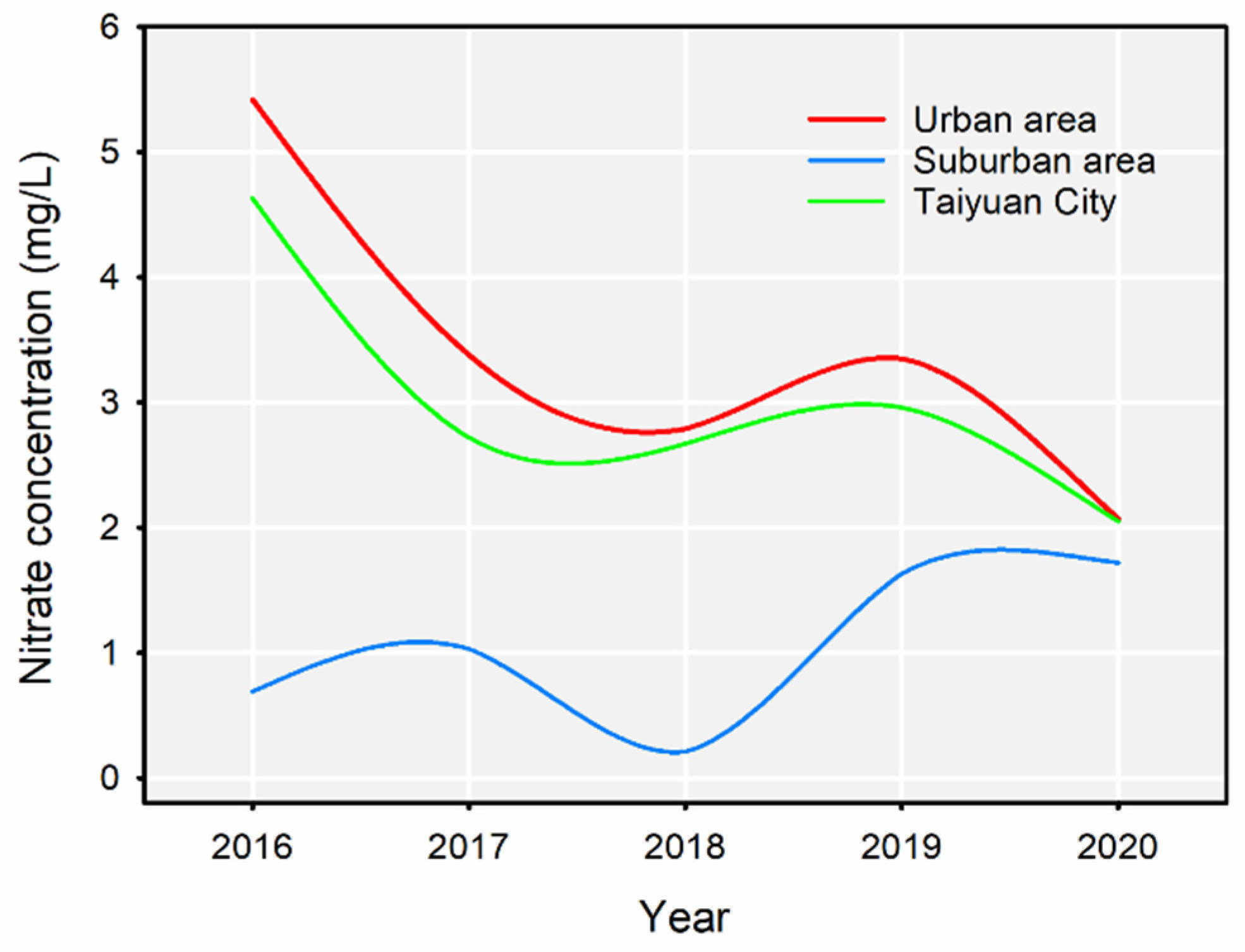
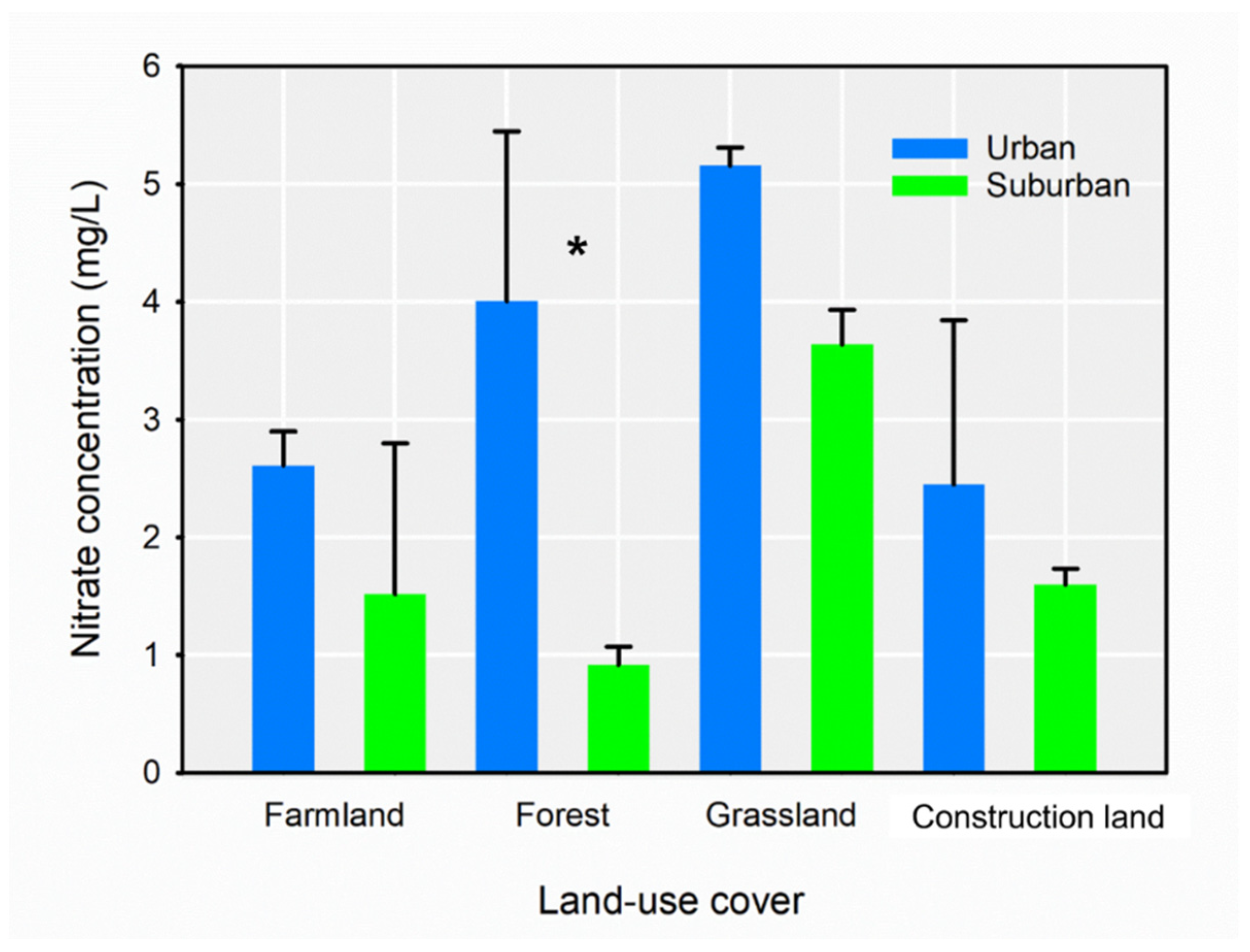
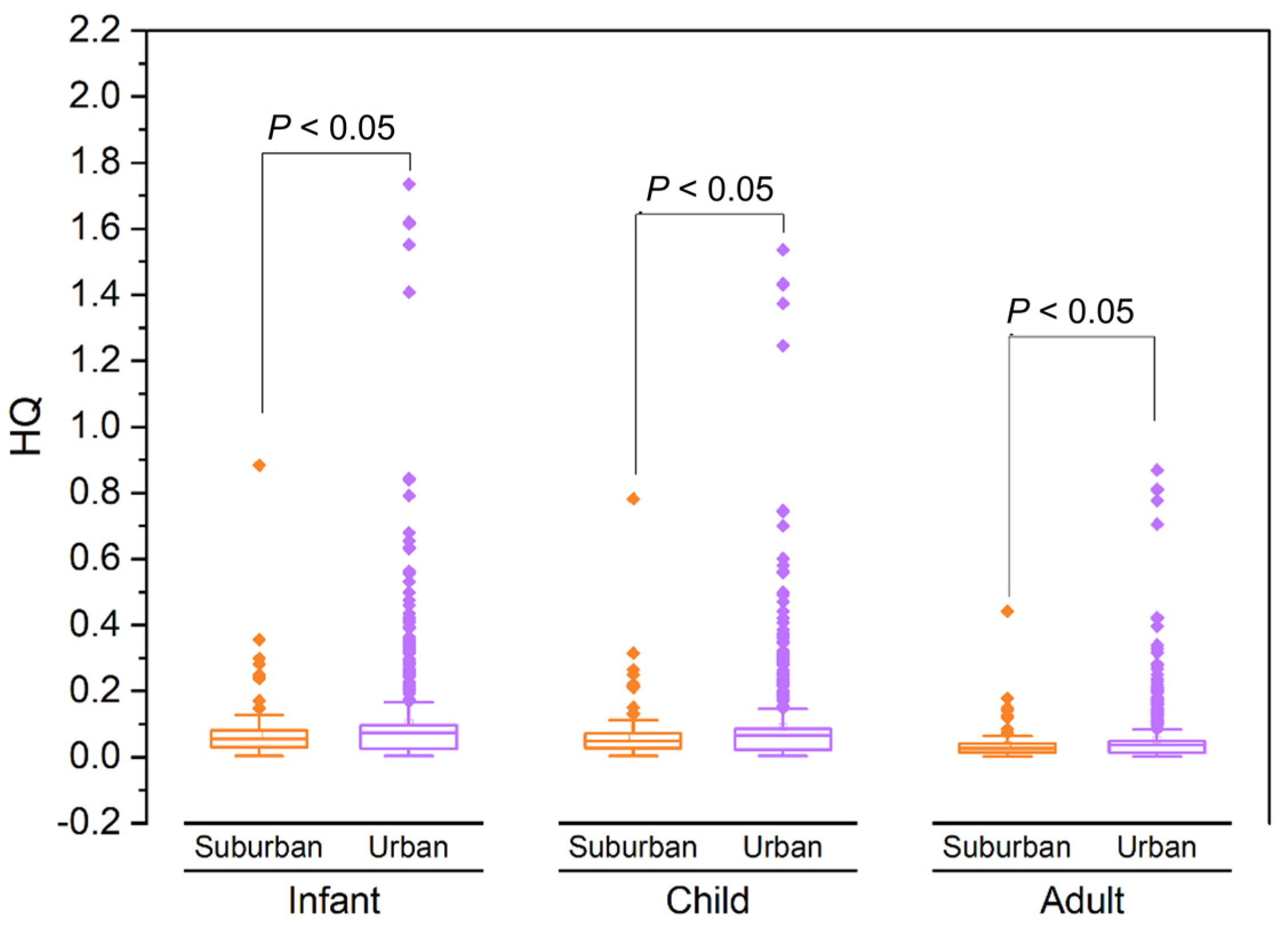
| Risk Exposure Factors | Age Groups | |||
|---|---|---|---|---|
| Infants | Children | Adults | Unit | |
| IR | 0.64 | 0.85 | 2.5 | L/day |
| EF | 365 | 365 | 365 | Day/year |
| ED | 1 | 4 | 40 | years |
| BW | 10 | 15 | 78 | kg |
| AT | 365 | 1460 | 14600 | Days |
| Sampling Region | Age Groups | HQ | SR | ||
|---|---|---|---|---|---|
| Mean | Maximum | Minimum | |||
| Urban | Infant | 0.10 | 1.74 | 0.00 | 0.17 |
| Children | 0.09 | 1.54 | 0.00 | 0.15 | |
| Adult | 0.05 | 0.87 | 0.00 | 0.09 | |
| Suburban | Infant | 0.07 | 0.88 | 0.00 | 0.08 |
| Children | 0.06 | 0.78 | 0.00 | 0.07 | |
| Adult | 0.03 | 0.44 | 0.00 | 0.04 | |
| Taiyuan City | Infant | 0.10 | 1.74 | 0.00 | 0.16 |
| Children | 0.09 | 1.54 | 0.00 | 0.14 | |
| Adult | 0.05 | 0.87 | 0.00 | 0.08 | |
Disclaimer/Publisher’s Note: The statements, opinions and data contained in all publications are solely those of the individual author(s) and contributor(s) and not of MDPI and/or the editor(s). MDPI and/or the editor(s) disclaim responsibility for any injury to people or property resulting from any ideas, methods, instructions or products referred to in the content. |
© 2023 by the authors. Licensee MDPI, Basel, Switzerland. This article is an open access article distributed under the terms and conditions of the Creative Commons Attribution (CC BY) license (https://creativecommons.org/licenses/by/4.0/).
Share and Cite
Mi, W.; Zhang, M.; Li, Y.; Jing, X.; Pan, W.; Xing, X.; Xiao, C.; He, Q.; Bi, Y. Spatio-Temporal Pattern of Groundwater Nitrate-Nitrogen and Its Potential Human Health Risk in a Severe Water Shortage Region. Sustainability 2023, 15, 14284. https://doi.org/10.3390/su151914284
Mi W, Zhang M, Li Y, Jing X, Pan W, Xing X, Xiao C, He Q, Bi Y. Spatio-Temporal Pattern of Groundwater Nitrate-Nitrogen and Its Potential Human Health Risk in a Severe Water Shortage Region. Sustainability. 2023; 15(19):14284. https://doi.org/10.3390/su151914284
Chicago/Turabian StyleMi, Wujuan, Minghua Zhang, Yuan Li, Xiaoxuan Jing, Wei Pan, Xin Xing, Chen Xiao, Qiusheng He, and Yonghong Bi. 2023. "Spatio-Temporal Pattern of Groundwater Nitrate-Nitrogen and Its Potential Human Health Risk in a Severe Water Shortage Region" Sustainability 15, no. 19: 14284. https://doi.org/10.3390/su151914284
APA StyleMi, W., Zhang, M., Li, Y., Jing, X., Pan, W., Xing, X., Xiao, C., He, Q., & Bi, Y. (2023). Spatio-Temporal Pattern of Groundwater Nitrate-Nitrogen and Its Potential Human Health Risk in a Severe Water Shortage Region. Sustainability, 15(19), 14284. https://doi.org/10.3390/su151914284







